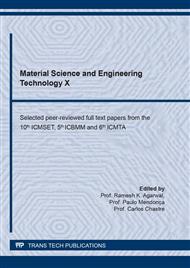[1]
T. Daiki, I. Ichio, H. Shin-ichiro, D. Shigeyuki: Basic Research on Compaction Performance of Concrete, Proceedings of the Japan Concrete Institute, Vol. 39, No.1, (2017), pp.1273-1278 (in Japanese).
Google Scholar
[2]
O. Akira, U. Taketo: Study on dispersion effect of the polycarboxylic acid-based dispersant to fine powder particles, Journal of Concrete Engineering Annual Papers, Vol.10, (1999), pp.79-84 (in Japanese).
Google Scholar
[3]
S. Mitsugu: Materials for High Flowability -Chemical Admixtures-, Concrete Journal. vol.32, No7, (1994), pp.64-69 (in Japanese).
Google Scholar
[4]
Y. Kazuhiro, S. Etsuo, D. Masaki, K. Ayao: Steric Hindrance Effect of Superplasticizer on the Dispersion of Cement Particles, Proceedings of the Japan Concrete Institute, vol.16, No1, (1994), pp.335-340 (in Japanese).
Google Scholar
[5]
O. Akira, U. Taketo: Dispersing Effect of Polycarboxylate-Based Superplasticizers for Binder Particles, Proceedings of the Japan Concrete Institute, Vol.20, No.2, (1998), pp.85-90 (in Japanese).
Google Scholar
[6]
Japan Society of Civil Engineers: Standard Specifications for Concrete, Established in (2012).
Google Scholar
[7]
I. Mihoko, M. Kyuishi, M. Shoichi, S. Noboru: Flowability Keeping Mechanism of Self-Compacting Concrete, Proceedings of the Japan Concrete Institute, Vol.18,No.1, (1996), pp.129-134 (in Japanese).
Google Scholar
[8]
H. Tsuyoshi, N. Toyoharu: The Effect of Polycarboxylate-type Superplasticizer Controlled Its Adsorption Rate onto The Cement Particles by Changing The Polymer Structure, Journal of Structural and Construction Engineering (Transactions of AIJ), vol.74,No639,(2009), pp.765-773 (in Japanese).
DOI: 10.3130/aijs.74.765
Google Scholar
[9]
R.J. Flatt, J.Zimmermann, C.C. Hampel, C.Kurz, I.Schober, L.Frunz, C. Plassard, and E. Lesniewska: The role of adsorption energy in the sulfate–polycarboxylate competition, ACI International Conference, Vol.262, (2009), pp.153-164.
Google Scholar
[10]
Takigawa, M., Faraidoon, R., Kit, R., Date, S.: Basic Research of Improving the Mortar Flow by Thermal Stimulation to Superplasticizer, MATEC Web of Conferences,278, 01003, (2018), pp.1-6.
DOI: 10.1051/matecconf/201927801003
Google Scholar
[11]
Takigawa, M., Bomura, Y., Hashimoto, S., Date, S.:Effect of Thermal Stimulation on Various Characteristics of Superplasticizer, International Journal of Engineering and Technology, Vol.11, No.4, (2019), pp.262-266.
DOI: 10.7763/ijet.2019.v11.1158
Google Scholar
[12]
M. Takeshi, S. Yoshiaki, U. Kenji, O. Toshihiro: Study on Differences in Shrinkage Cracking Properties between Mortar and Concrete, Proceedings of the Japan Concrete Institute, Vol.36, No.1, (2014), pp.472-477 (in Japanese).
Google Scholar
[13]
Shi C.: Steel Slag Its Production, Processing, Characteristics, and Cementitious Properties, Journal of Materials in Civil Engineering, Vol. 16, Issue 3, (2004), pp.230-236.
DOI: 10.1061/(asce)0899-1561(2004)16:3(230)
Google Scholar
[14]
Wang, Q., Yan P., Yang J., Zhang B.: Influence os steel slag on mechanical properties and durability of concrete, Construction and Building Materials, Vol.47, (2013), pp.1414-1420.
DOI: 10.1016/j.conbuildmat.2013.06.044
Google Scholar
[15]
Hiroyasu S., Mitsuo O., Yuki Sakaguchi, Hiroaki M.: A Study on Initial Stresses in Steam-Cured Precast Concrete Members. Proceedings of he Japan Concrete Institute, Vol.33, No.1, (2011), pp.443-448.
Google Scholar
[16]
Shigeyuki D.: Current Status of Utilization of Precast Products in Construction Work. Construction Machinery and Construction Association, Vol.71, No.9, (2019), pp.25-36(in Japanese).
Google Scholar


